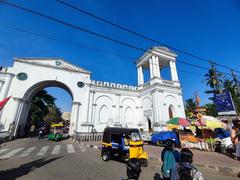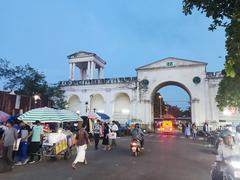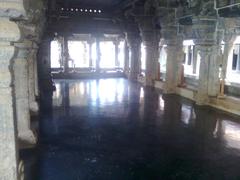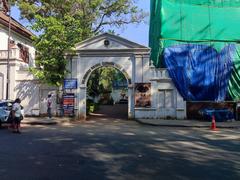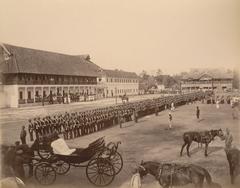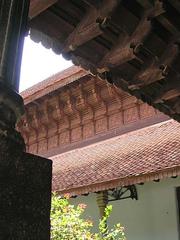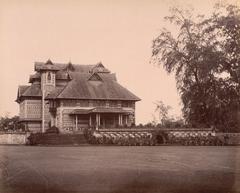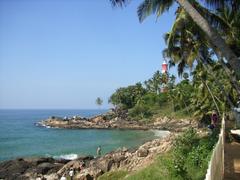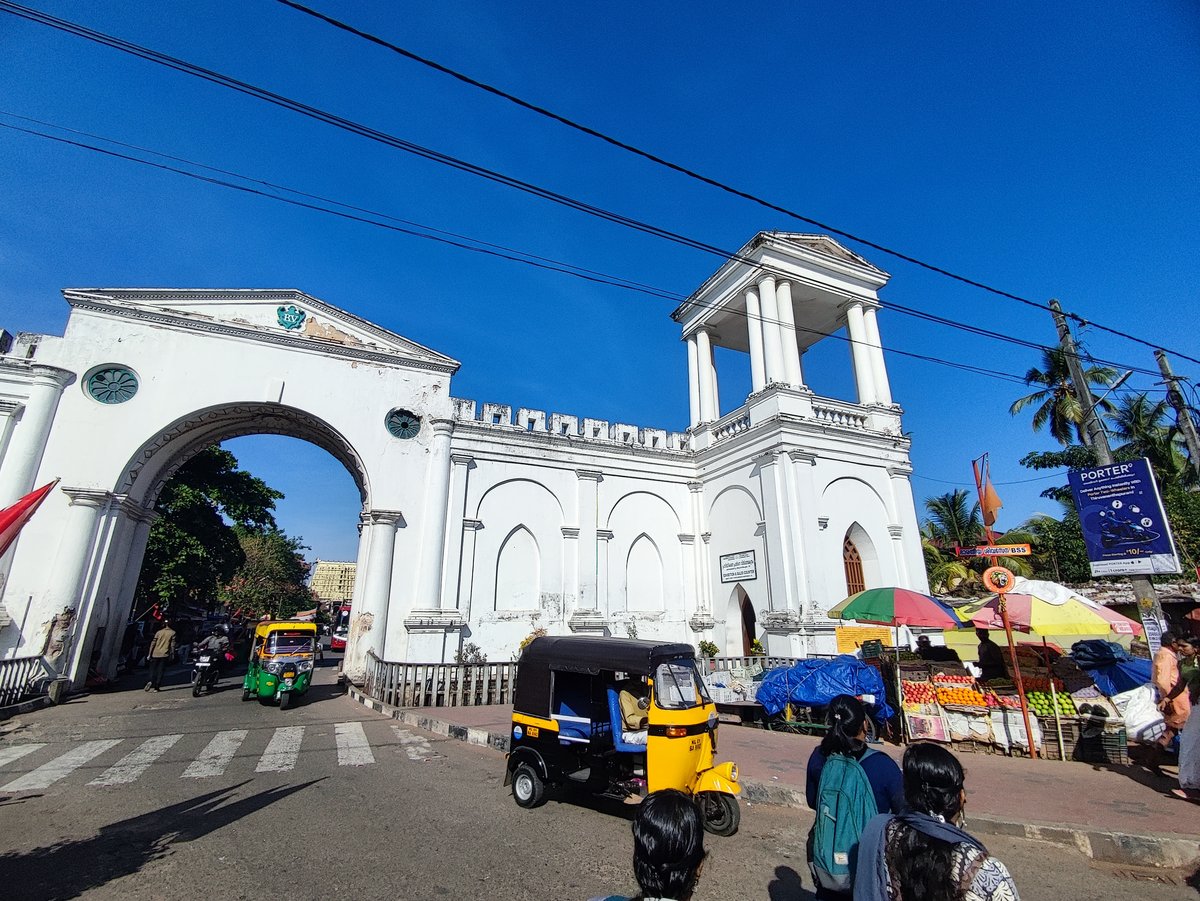
East Fort Thiruvananthapuram: Visiting Hours, Tickets, and Historical Sites
Date: 16/08/2024
Introduction
East Fort, located in the heart of Thiruvananthapuram, Kerala, is a historical and cultural landmark that offers a rich tapestry of heritage and modernity. This guide aims to provide visitors with comprehensive information on exploring East Fort, including its key attractions, historical and architectural significance, visiting hours, ticket prices, and practical travel tips. The fort area has been a focal point of the Travancore Kingdom since the late 18th century, strategically chosen to fortify the region and consolidate power around the revered Sree Padmanabha Swamy Temple (Kerala Government Town Planning). Today, East Fort is not just a historical site but a vibrant cultural hub, home to important institutions and bustling markets. From the iconic Sree Padmanabha Swamy Temple to the bustling Chalai Market, East Fort encapsulates the spirit of Thiruvananthapuram, offering visitors a unique blend of history, culture, and modern-day attractions. Whether you are a history enthusiast, a cultural explorer, or a casual tourist, this guide will help you navigate through the myriad of experiences that East Fort has to offer.
Table of Contents
- Introduction
- Historical Background
- Architectural Marvels
- Cultural Significance
- Social Hierarchy and Settlement Patterns
- Heritage Conservation
- Modern Transformations
- Key Attractions
- Travel Tips and Nearby Attractions
- FAQ
- Conclusion
Exploring East Fort, Thiruvananthapuram: Visiting Hours, Tickets, and Historical Significance
Historical Background
East Fort, located in Thiruvananthapuram, Kerala, is a site of immense historical significance. The fort’s origins date back to the late 18th century when the capital of the Travancore Kingdom was shifted from Padmanabhapuram to Thiruvananthapuram. This strategic move was aimed at fortifying the kingdom’s defenses and consolidating power around the Sree Padmanabha Swamy Temple, a revered Hindu shrine (Kerala Government Town Planning).
Architectural Marvels
The East Fort area is renowned for its unique architectural heritage, which includes several palaces and traditional houses known as agraharams. The agraharams, primarily inhabited by the Tamil Brahmin community, are characterized by their distinctive layout and design. These residential clusters are often arranged in concentric circles around the temple, similar to the layout seen in Srirangam, another prominent temple town in South India (Kerala Government Town Planning). Notable palaces within the fort area include the Kuthira Mālika, Krishna Vilasam, Anantha Vilasam, Ranga Vilasam, Saraswathy Vilasam, Sundara Vilasam, Sreepādam, and Bhajanappura Kottaram. These palaces, with their intricate architectural details and historical significance, add to the fort’s charm and allure (Kerala Government Town Planning).
Cultural Significance
East Fort is not just a historical site but also a cultural hub. The area is home to several institutions that uphold the cultural ethos of Thiruvananthapuram. The Navarathri Mandapam, Theerthapada Mandapam, C.V.N. Kalari, and Margi are some of the prominent cultural centers that contribute to the rich cultural tapestry of the city (Kerala Government Town Planning).
Social Hierarchy and Settlement Patterns
The settlement pattern within East Fort historically reflected the strict caste hierarchy prevalent in the region. The Kshatriyas (rulers), Brahmins (Vedic scholars and priests), and the aristocratic landed gentry were the privileged communities that resided within the fort’s precincts. The agraharams, which housed the Tamil Brahmin community, were strategically located around the Sree Padmanabha Swamy Temple, signifying their importance in the social and religious fabric of the city (Kerala Government Town Planning).
Heritage Conservation
Recognizing the rich architectural and cultural values associated with the historic fort area, the Art and Heritage Commission has identified East Fort as a Heritage Zone. This designation aims to preserve the tangible and intangible heritage components within the area. The State Archaeological Department has identified 28 historical monuments as protected, while the Art and Heritage Commission has added a further 21 historical components to the list (Kerala Government Town Planning).
Modern Transformations
Despite its historical and cultural significance, East Fort has not been immune to modern interventions. Many of the traditional agraharam houses and heritage buildings have undergone significant transformations, often using incompatible modern building materials. This has led to a loss of the area’s quaint heritage charm. Efforts are ongoing to raise awareness about the historic importance of these structures and promote the use of traditional construction techniques in restoration projects (Kerala Government Town Planning).
Key Attractions
Sree Padmanabha Swamy Temple
At the heart of East Fort lies the Sree Padmanabha Swamy Temple, one of the most iconic landmarks in Thiruvananthapuram. The temple is dedicated to Lord Vishnu and is renowned for its Dravidian style architecture. The temple’s sanctum houses a massive idol of Lord Vishnu reclining on the serpent Anantha, which is a sight to behold for devotees and tourists alike (Kerala Government Town Planning).
Visiting Hours: 3:30 AM - 12:00 PM, 5:00 PM - 7:20 PM
Ticket Price: Free entry, special darshan tickets available
Kuthira Mālika (Puthen Malika) Palace
Adjacent to the Sree Padmanabha Swamy Temple is the Kuthira Mālika Palace, also known as Puthen Malika. This palace, built by Maharaja Swathi Thirunal Balarama Varma, is a fine example of traditional Kerala architecture. The palace gets its name from the 122 wooden horses that adorn its exterior. Today, it houses a museum that showcases various artifacts from the Travancore royal family (Kerala Government Town Planning).
Visiting Hours: 8:30 AM - 12:30 PM, 3:30 PM - 5:30 PM
Ticket Price: INR 20 for adults, INR 10 for children
Padmatheertham and Mitranandapuram Temple Tanks
The Padmatheertham and Mitranandapuram temple tanks are significant water bodies within the fort area. These tanks not only serve religious purposes but also add to the aesthetic and environmental value of the region. The serene waters of these tanks provide a tranquil setting for visitors and are integral to the temple rituals (Kerala Government Town Planning).
Gandhi Park
Situated in front of the East Fort, Gandhi Park is a popular spot for both locals and tourists. The park has been recently remodeled with modern urban landscaping and serves as a venue for social and political gatherings. It provides a serene environment for relaxation and offers a beautiful view of the illuminated East Fort entrance at night (Wikipedia).
Visiting Hours: Open 24 hours
Tickets: Free entry
Chalai Market
Adjacent to the East Fort is the bustling Chalai Market, one of the oldest and busiest markets in Thiruvananthapuram. This market is a shopper’s paradise, offering everything from fresh produce to textiles, jewelry, and household items. The market’s vibrant atmosphere and the variety of goods available make it a must-visit for anyone looking to experience the local culture and commerce (Wikipedia).
Visiting Hours: 9:00 AM - 9:00 PM
Tickets: Free entry
Pazhavangadi Ganapathy Temple
Another significant temple located within the East Fort area is the Pazhavangadi Ganapathy Temple. Dedicated to Lord Ganesha, this temple is known for its unique idol of the deity in a seated posture with the right leg folded. The temple is a popular spot for devotees and tourists alike, and it is customary to break a coconut as an offering to Lord Ganesha (Wikipedia).
Visiting Hours: 4:30 AM - 10:45 AM, 5:00 PM - 8:30 PM
Tickets: Free entry
Karthika Thirunal Theatre and Theerthapada Mandapam
For those interested in cultural activities, the Karthika Thirunal Theatre and Theerthapada Mandapam are venues where various cultural programs are staged, especially in the evenings. These venues host a range of performances, including classical music, dance, and drama, providing visitors with an opportunity to experience the rich cultural traditions of Kerala (Kerala Tourism).
Visiting Hours: Depends on event schedules
Tickets: Varies by event
Navarathri Mandapam
The Navarathri Mandapam, located within the East Fort complex, is famous for hosting the annual Navarathri celebrations. This ten-day festival is marked by a series of music concerts featuring prominent artists from across the country. The mandapam itself is an architectural marvel, and the festival is a significant cultural event that attracts music lovers from far and wide (4Kerala).
Visiting Hours: During Navarathri festival
Tickets: Free entry
Ananthavilasam Palace
Built by King Vishakam Thirunal in 1880, the Ananthavilasam Palace is another architectural gem within the East Fort. Constructed in the Baroque and Rococo styles, this palace showcases the opulence and grandeur of the Travancore royal family. Although not as well-known as other attractions, it is worth a visit for those interested in historical architecture (4Kerala).
Visiting Hours: 10:00 AM - 5:00 PM
Tickets: INR 20 for adults, INR 10 for children
Methan Mani
One of the unique attractions near the East Fort is the Methan Mani, a clock with a man’s face and two goats on either side of its dial. This quirky clock is a popular landmark and adds a touch of whimsy to the historical surroundings. It is located near the Sree Padmanabhaswamy Temple and is a fun sight to check out while exploring the area (4Kerala).
Visiting Hours: Open 24 hours
Tickets: Free entry
Shopping and Dining
East Fort is a bustling commercial hub with numerous shops and eateries. Visitors can explore a variety of stores selling traditional Kerala dress materials, jewelry, handicrafts, and snacks. Some of the prominent jewelry brands with shops in the area include Alukkas, Alappat, Josco, Prince, and Kalyan. For dining, there are several local restaurants and street food vendors offering delicious Kerala cuisine (Wikipedia).
Travel Tips and Nearby Attractions
- Travel Tips: Wear comfortable shoes as you will be walking a lot. Carry water and stay hydrated. Respect the local customs and dress modestly when visiting religious sites.
- Nearby Attractions: The Napier Museum, Thiruvananthapuram Zoo, and the Kanakakunnu Palace are all within a short distance from East Fort and are worth a visit.
- Best Photographic Spots: The entrance of East Fort, the Sree Padmanabha Swamy Temple, and the Kuthira Mālika Palace offer excellent opportunities for photography.
- Guided Tours: Local guides are available for hire to provide detailed insights into the historical and cultural significance of the area.
FAQ
Q: What are the opening hours of East Fort?
A: East Fort itself is accessible at all times, but specific attractions within the fort have their own visiting hours.
Q: How much does a ticket to East Fort cost?
A: Entry to East Fort is free, but individual attractions like the Kuthira Mālika Palace Museum may have ticket prices.
Q: Are there any special events at East Fort?
A: Yes, East Fort hosts several cultural events, especially during the Navaratri festival. Check local listings for more details.
Conclusion
East Fort in Thiruvananthapuram stands as a testament to the rich historical and cultural heritage of Kerala. Its origins, dating back to the late 18th century, offer a glimpse into the strategic and religious significance of the region during the Travancore Kingdom era (Kerala Government Town Planning). Today, East Fort is a vibrant cultural hub where ancient traditions seamlessly blend with modernity. From the majestic Sree Padmanabha Swamy Temple and the exquisite Kuthira Mālika Palace to the bustling Chalai Market and serene Gandhi Park, East Fort offers a diverse array of experiences for visitors. Efforts to preserve and promote the heritage of East Fort are crucial in maintaining its charm and significance for future generations. As you explore this historical treasure trove, you will not only witness the architectural marvels and cultural richness but also gain a deeper understanding of the social and historical fabric that has shaped Thiruvananthapuram. We encourage you to stay updated with the latest travel tips and cultural events by following us on social media or downloading our mobile app, Audiala.
References
- Kerala Government Town Planning Department. (2019). Fort Area Trivandrum City. Kerala Government Town Planning
- Kerala Tourism. (2010). East Fort Thiruvananthapuram. Kerala Tourism
- Wikipedia contributors. (n.d.). East Fort. Wikipedia, The Free Encyclopedia. Retrieved Wikipedia
- 4Kerala. (n.d.). East Fort and the Heritage Tour. 4Kerala
